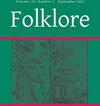别墅在哪里?回到一个简单的问题
IF 0.3
4区 社会学
0 FOLKLORE
引用次数: 1
摘要
摘要本文追溯了南斯拉夫别墅学术分析的历史。通过问一个简单的问题,“别墅在哪里?”的时候,我就会回到那个学术领域,剔除有问题的旧理论,澄清历史猜想。我通过回归19世纪和20世纪农民故事讲述者、歌手和其他传统承送者的艺术和主张,对起源的分析进行了改进。本文章由计算机程序翻译,如有差异,请以英文原文为准。
Where Does the Vila Live? Returning to a Simple Question
Abstract This article traces the history of scholarly analysis of the South Slavic vila. By asking a simple question, ‘where does the vila live?’, I return to that scholarship to weed out problematic older theories and clarify historical conjecture. I offer a refinement of the analysis of origin by returning to the art and assertions of nineteenth- and twentieth-century peasant storytellers, singers, and other tradition-bearers.
求助全文
通过发布文献求助,成功后即可免费获取论文全文。
去求助
来源期刊

FOLKLORE
FOLKLORE-
CiteScore
0.60
自引率
25.00%
发文量
0
期刊介绍:
A fully peer-reviewed international journal of folklore and folkloristics. Folklore is one of the earliest journals in the field of folkloristics, first published as The Folk-Lore Record in 1878. Folklore publishes ethnographical and analytical essays on vernacular culture worldwide, specializing in traditional narrative, language, music, song, dance, drama, foodways, medicine, arts and crafts, popular religion, and belief. It reviews current studies in a wide range of adjacent disciplines including anthropology, cultural studies, ethnology, history, literature, and religion. Folklore prides itself on its special mix of reviews, analysis, ethnography, and debate; its combination of European and North American approaches to the study of folklore; and its coverage not only of the materials and processes of folklore, but also of the history, methods, and theory of folkloristics. Folklore aims to be lively, informative and accessible, while maintaining high standards of scholarship.
 求助内容:
求助内容: 应助结果提醒方式:
应助结果提醒方式:


